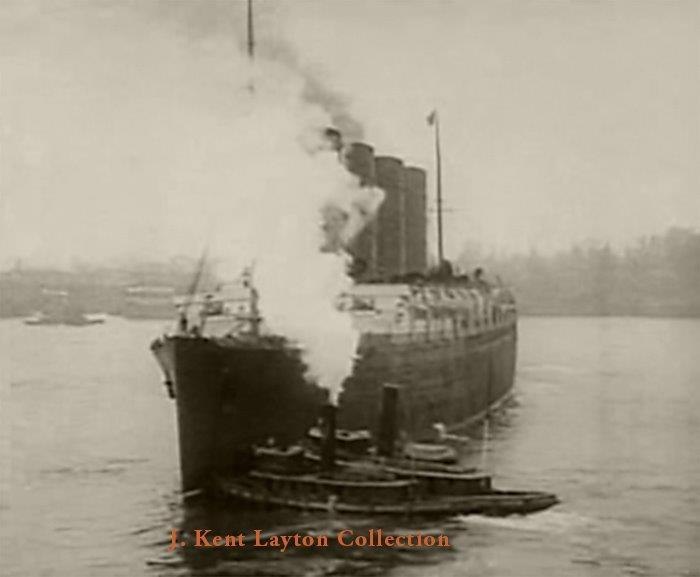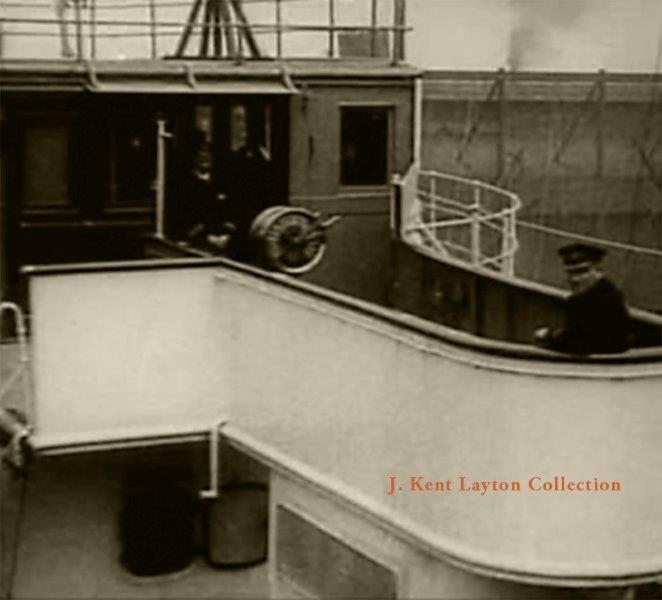The Lusitania’s last voyage
This is the 8th blog post in a series by J Kent Layton, maritime historian and author of ‘Lusitania: an illustrated biography’, to accompany the exhibition Lusitania: life, loss, legacy at the Maritime Museum.

Clear of the pier, the Lusitania turns to depart New York. © J Kent Layton Collection
At 12.15pm on 1 May 1915 the Lusitania cast off from Cunard's New York Pier 54 for the 101st time, starting her 202nd crossing of the Atlantic. Her Captain, William Thomas Turner, eased himself into the curve of the starboard Bridge wing to watch the ship's departure. He turned, perhaps a little startled, and noticed that he was being filmed by a camera crew located on the roof of Pier 54, just slightly above him as he slid past. The ship was then turned south toward open water, and proceeded toward the North Atlantic. It had been an eventful morning. The German Ambassador to the United States had planned to run a notice in American papers on 24 April, addressing passengers planning to embark on any British passenger ships. It reminded them that British ships were subject to attack without warning in the War Zone, and that they travelled on those ships at their own risk. Due to technical problems, the notice had not run on 24 April, and instead first ran on the morning of 1 May. It was placed on the shipping advertisements pages, and in a number of cases found itself placed close to Cunard ads for the Lusitania's sailing.
The Lusitania backs out from her New York pier on 1 May 1915. © J Kent Layton Collection
Newspaper reporters and a camera crew descended on the pier. Some passengers, and a good many of their relatives or friends who were not traveling were nervous, but Cunard's New York manager, CP Sumner, reported that no one had cancelled their passage as a result. As the liner struck out into the open sea, the nerves and excitement surrounding talk of submarines began to fade away, and the quiet routine of shipboard life began to set in. The Lusitania proceeded east as she had 100 times before, and the voyage seemed rather normal. The meals were wonderful, and a quiet routine began to set in. Some could even have been excused for forgetting that all of Europe was engulfed in an unprecedented war. On 6 May, however, the illusion began to fade. That morning, the lifeboats were swung out in preparation for entry into the War Zone. Passengers began to remember the dangers lurking ahead of them, and an undercurrent of tension began to build on board.
As a result of their intelligence operations—which gave them some details about what German submarines were operating in the War Zone—and as a result of the attacks upon several merchant vessels on 5-6 May, the Admiralty broadcast repeated wireless warnings to inbound merchant vessels. The messages reminded merchant captains that German submarines were active in the war zone, and gave their general area of activity. Merchant captains were to implement previous advices and directives which the Admiralty had issued to help them protect their ships from attack. Captain Turner reassured passengers on the evening of the 6 May that their passage through the War Zone would be made at utmost speed. He seemed confident enough. However that night, many passengers grew increasingly anxious. Some slept fully dressed, and some even slept in the public rooms which were located on the upper decks... and close to the lifeboats in case the liner was attacked.
Captain Turner spots a film crew on the New York pier
as the Lusitania departs for the last time. © J Kent Layton Collection


